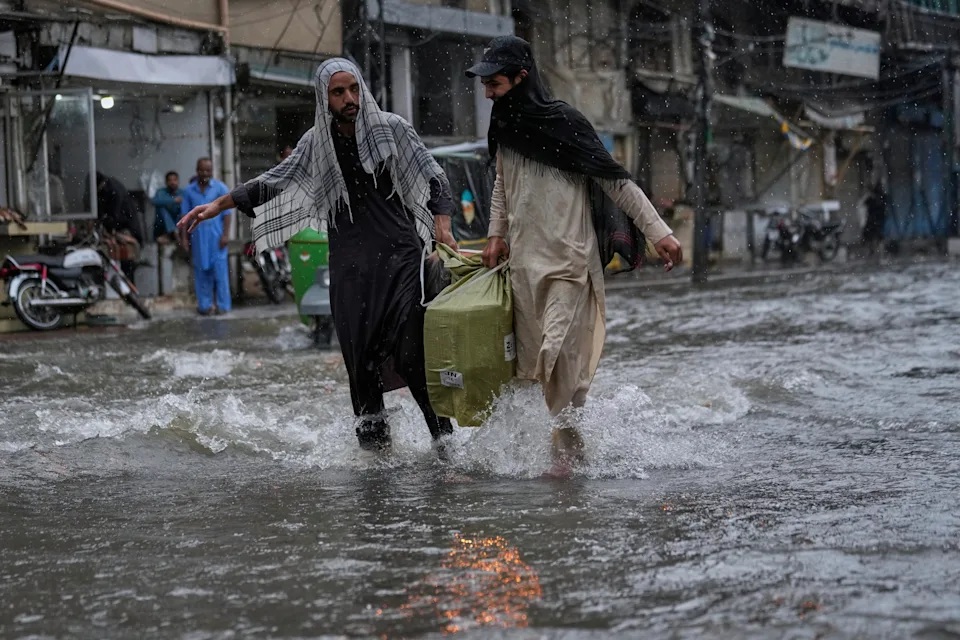News
Drenched in Grief: Monsoon Rains Kill Dozens in Pakistan

Torrential monsoon rains sweeping across Pakistan’s Punjab province have resulted in the deaths of at least 63 people and left nearly 290 injured within just 24 hours, according to the National Disaster Management Authority (NDMA).
The intense downpours began early Wednesday, triggering widespread devastation across the region, according to local media reports.
The majority of fatalities occurred due to buildings collapsing under the weight of accumulated water.
Others reportedly died by drowning or electrocution as water levels surged and infrastructure failed under pressure.
In Rawalpindi, a densely populated city adjacent to the capital Islamabad, local authorities declared Thursday a public holiday in an attempt to keep residents indoors and minimize casualties.
Those living along the banks of the city’s swollen river were advised to evacuate immediately, as water levels continued to rise and the risk of flash flooding increased.
The recent deaths have pushed the nationwide toll from monsoon-related incidents to nearly 180 since the start of the season in late June.
Alarmingly, over half of those killed have been children, according to official estimates.
The extreme weather has also brought transportation to a standstill in parts of Punjab.
Major highways and expressways have been submerged or rendered impassable due to floodwaters, and numerous domestic flights have been either delayed or canceled as a result of the poor weather conditions.
In response to the unfolding crisis, Punjab’s Chief Minister Maryam Nawaz declared a state of emergency in several affected districts.
In a statement posted on X (formerly Twitter), she assured the public that government agencies were actively engaged in relief operations and urged residents to strictly follow safety advisories.
“We are working with all resources available,” she emphasized.
The city of Chakwal has been one of the worst affected areas, receiving an extraordinary 400mm of rainfall in just one day.
Dramatic images and videos from the city show rescue workers navigating through submerged streets in boats as they search for residents stranded by floodwaters.
Helicopters dispatched by the military have also been deployed to monitor and assist in the rescue efforts.
Officials have warned that the situation may worsen before it improves.
With more rainfall and potential flash flooding forecast through the weekend, thousands of emergency responders across Punjab have been placed on high alert and remain ready for deployment at a moment’s notice.
Pakistan, home to nearly 250 million people, continues to be one of the countries most acutely affected by climate change.
Its geographic position leaves it vulnerable to both extreme heat and monsoon-related deluges.
The country also contains more than 13,000 glaciers, many of which are melting at an accelerated rate due to rising global temperatures, exacerbating flood risks.
The current monsoon disaster brings back painful memories of 2022, when unprecedented rains submerged a third of the country.
That catastrophe claimed over 1,700 lives and inflicted more than $30 billion in economic damage.
Vast stretches of land were turned into inland lakes, destroying crops, homes, roads, and vital infrastructure.
In 2023, United Nations Secretary-General António Guterres highlighted Pakistan’s plight in the face of climate-driven disasters.
He called on the international community to support the country’s recovery efforts.
Guterres noted that Pakistan was “doubly victimised” both by the direct impact of climate change and by what he described as a “morally bankrupt” global financial system that had failed to provide adequate relief or resources.
Today, as torrential rains once again sweep across its provinces, Pakistan finds itself bracing for further hardship.
The mounting toll underscores the country’s vulnerability and the urgent need for global cooperation in combating climate-related threats.
With many areas still submerged and thousands at risk, the full impact of this week’s rainfall is yet to be seen.
As weather systems continue to pound the region, the country’s infrastructure, emergency services, and people face a critical test in what is becoming an all-too-familiar battle with nature.
For Diaspora Digital Media Updates click on Whatsapp, or Telegram. For eyewitness accounts/ reports/ articles, write to: citizenreports@diasporadigitalmedia.com. Follow us on X (Fomerly Twitter) or Facebook












